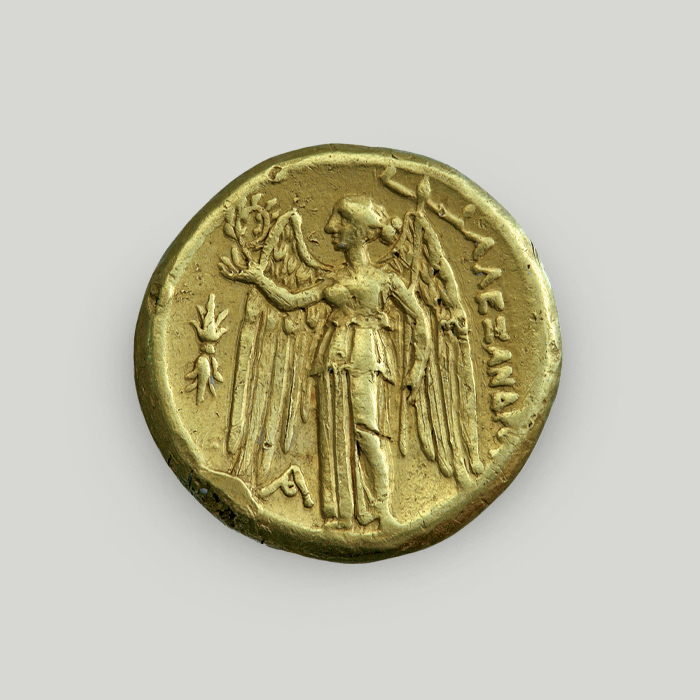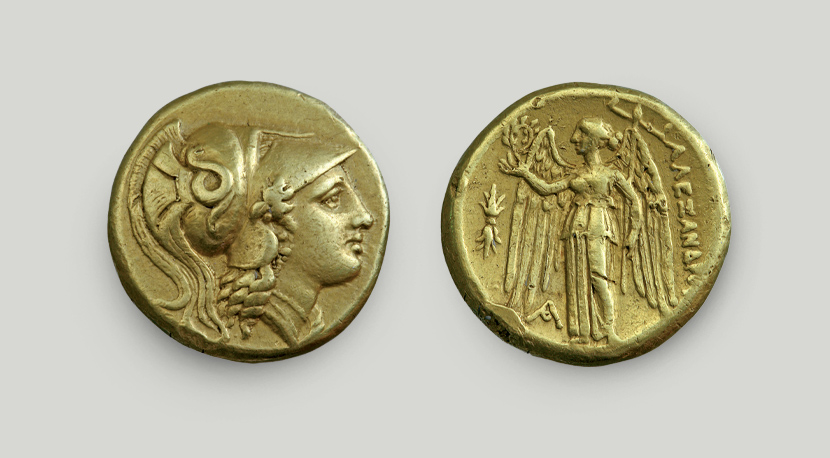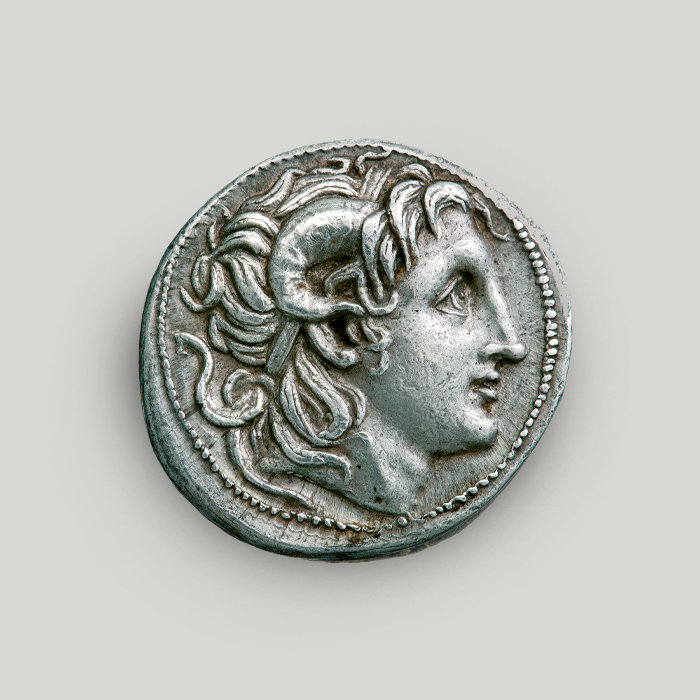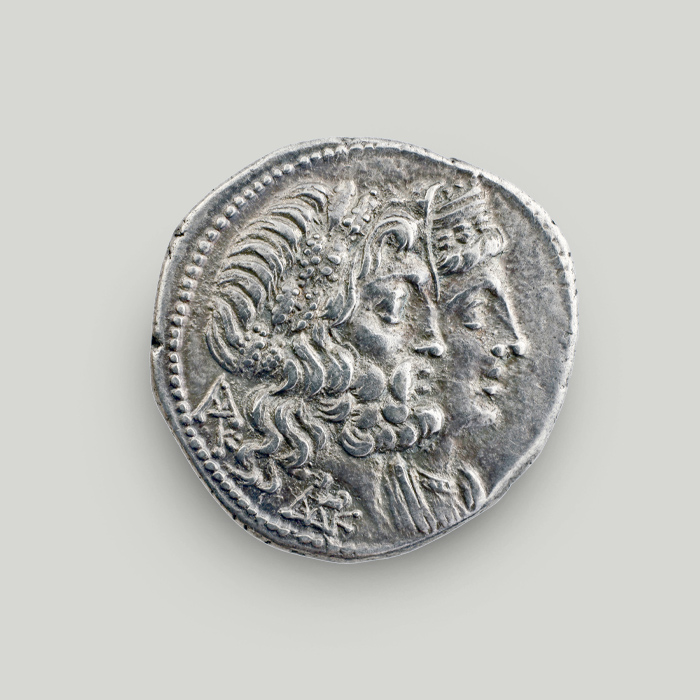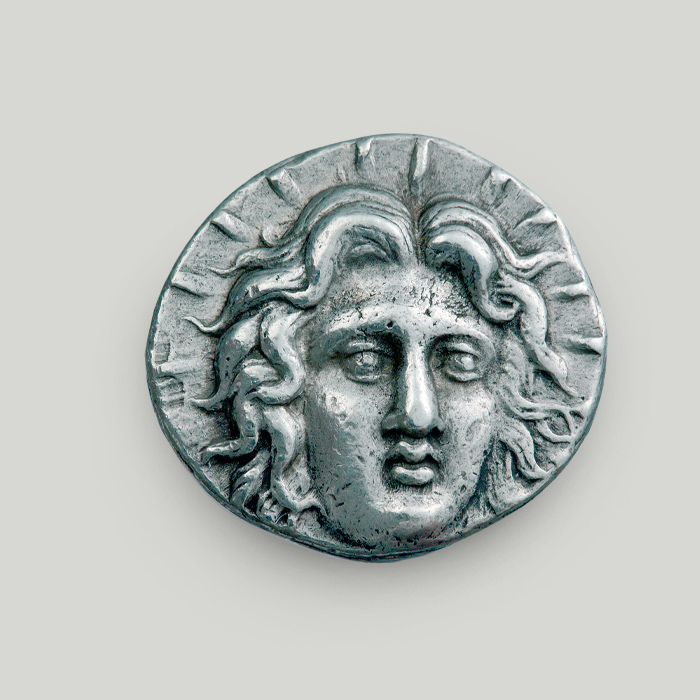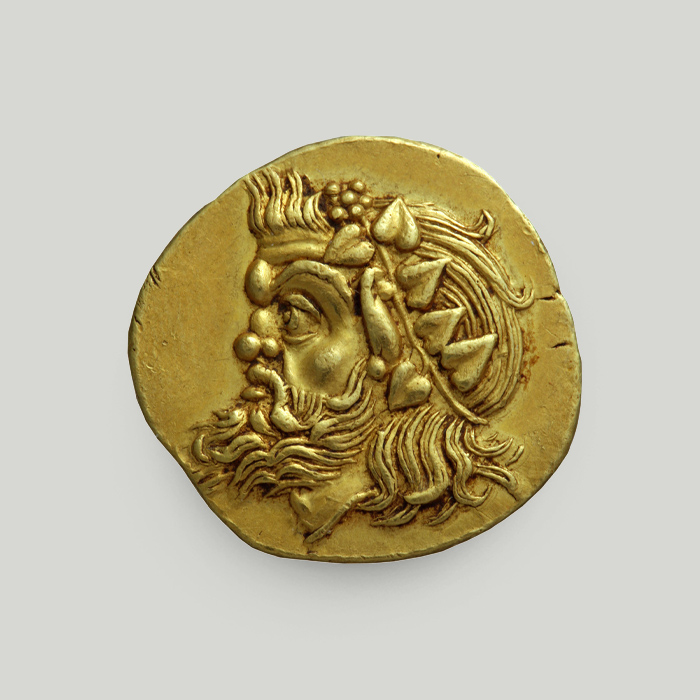Gold double stater of Alexander the Great, Macedon
The gold double stater of Alexander the Great was probably issued at the Aegae mint in present-day Vergina, Northern Greece. It belongs to the most prolific royal minting tradition in antiquity. Alexander III (also known as “the Great”) minted gold coins according to the Attic weight standard, most probably after the siege of Tyre (332 BCE).
Obverse
Head of Athena wearing a Corinthian-style helmet. The goddess is depicted in profile facing right.
Reverse
The winged goddess Nike (Victory) holding a wreath in her right hand and a ship mast in her left. A lightning bolt appears in the field on her left. There is a monogram under one of her wings. The legend on the right reads ΑΛΕΞΑΝΔΡΟΥ (of Alexander).
The young king and his first great victories
Alexander III ruled from 336 to 323 BCE and became known as Alexander the Great.
He was the son of Philip II of Macedon and his mother was the Epirote princess Olympias. In the context of his excellent upbringing, he was even tutored by the philosopher Aristotle.
At the age of 20, he succeeded his father on the throne of the Kingdom of Macedon.
After painstaking preparations, he led a Panhellenic campaign in 334 BCE. He set off for the Hellespont (present-day Strait of Gallipoli in Turkey) from the kingdom’s capital of Pella. The purpose of the campaign was to liberate all the Greek cities of Asia Minor.
Within a matter of a few years, he achieved great victories:
- He was victorious over the Persians at the Granicus River (334 BCE) and at Issus (332 BCE).
- He conquered the coastal cities of Tyre and Sidon in Phoenicia.
Then, he went on to found Alexandria – the greatest of many cities of the same name – in Egypt. This Alexandria was one of the 70 cities he founded in his lifetime.
While in Egypt, he visited the Temple of Amun in the Siwa Oasis. The priests there pronounced him son of Amun, the Egyptian equivalent of Zeus.
Alexander as king of Asia
In 331 BCE Alexander returned to Asia and crushed the forces of the Persian king Darius III at Gaugamela. With this victory, he dismantled the Persian empire once and for all. This feat gained him the title of “king of Asia”.
Alexander continued his expedition to the East:
- At Babylon, he was welcomed into the city as a liberator.
- He then captured the Persian capital of Susa.
- He stormed the Persian Gates.
- After that, he was able to conquer Persepolis, the ceremonial capital of the empire. There, he commanded that the palace of the Achaemenid dynasty – the one he had just overthrown – be destroyed, allegedly as revenge for the destruction wreaked by the Persians in Greece.
In 330 BCE Alexander’s Panhellenic campaign came to an end. When he reached the city of Ecbatana, Alexander let the allied Greek forces go.
The end of Alexander’s campaign and his sudden death
Alexander continued to advance to the regions of Bactria and Sogdiana, where he married Roxana, a local princess. He had a son by her called Alexander IV.
Turning to India, he conquered the city of Taxila. There, he formed an alliance with the local ruler and defeated King Porus during the battle at the Hydaspes River.
His troops, however, would no longer follow him into battle. For the first time in his life, Alexander had to retreat. He set out on his return through the harsh desert of Gedrosia.
In the spring of 323 BCE, he arrived once more in Babylon, where he intended to establish his empire’s new capital. After a banquet there, he fell ill and died within a matter of 10 days (13 June).
The most impressive royal coinage
The royal coinage struck by Alexander the Great is considered to have been the richest and most impressive in all antiquity.
Funding Alexander’s military campaigns required the continuous production of coins in mass quantities. To cover all the soldiers’ wages, 26 mints in Greece and Asia Minor operated day and night. One such mint was that of Aegae in present-day Vergina, where the gold double stater of Alpha Bank's Numismatic Collection was most probably minted.
Alexander III issued coins according to the Attic weight standard. In this he followed the practice of his father, Philip II of Macedon. Gold staters started to be minted probably after the conquest of Tyre (332 BCE).
At the same time, Alexander introduced a drastic reform in the coinage of Macedon. He issued silver tetradrachms according to the widely accepted Attic weight standard.
The goddess Athena and the winged Nike
Alexander’s choice of depictions was anything but random.
For the obverse of the gold double stater, he chose his patron goddess Athena. A goddess of wisdom and military virtue, Athena ensured victory and freedom.
Victory was also safeguarded by the winged goddess Nike (Greek for “victory”) on the reverse. There are 2 possible interpretations for the ship mast held by Nike:
- It is there to commemorate the Greek victory in the naval battle of Salamis during the Persian Wars.
- It is a symbol for Alexander’s conquest of the city of Tyre in 332 BCE. The second option is considered more plausible.
Staters in antiquity
The word “stater” corresponds to an ancient coin denomination. Etymologically, it is derived from the Phoenician schequel, which denoted a coin weighed to comply with a specific standard.
The weight of a stater varied significantly by region, and according to the weight standard applied by the mint.
The coin in our publications
The gold double stater of Alexander the Great is mentioned in the book Alexander the Great. From Macedonia to the Edge of the World, edited by Dr Dimitra Tsangari. The publication presents the history of Alexander the Great through his coinage and its effect on the ancient world even after his death. It includes photographs of 218 coins and detailed explanatory texts.
Buy the publication Alexander the Great. From Macedonia to the Edge of the World on the Alpha Bank e-shop.
The Alpha Bank Numismatic Collection is not open to the public.
Research visits to the Numismatic Collection can be organised upon request.
Contact us to book your visit.

